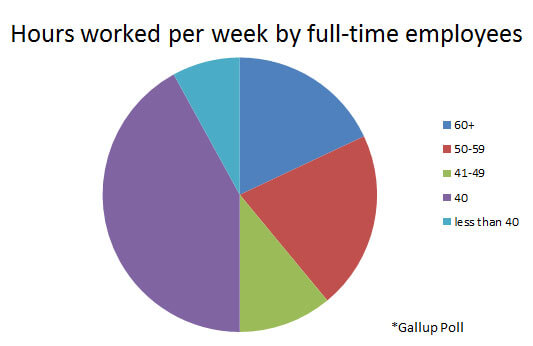Full-time employment often comes with benefits that are not typically offered to part-time, temporary, or flexible workers, such as annual leave, sick leave, and health insurance. Part-time jobs are mistakenly thought by some to not be careers. However, legislation exists to stop employers from discriminating against part-time workers so this should not be a factor when making decisions on career advancement. They generally pay more than part-time jobs per hour, and this is similarly discriminatory if the pay decision is based on part-time status as a primary factor. The Fair Labor Standards Act does not define full-time employment or part-time employment.
This is a matter generally to be determined by the employer . The definition by the employer can vary and is generally published in a company's Employee Handbook. Companies commonly require from 32 to 40 hours per week to be defined as full-time and therefore eligible for benefits. The Netherlands' average workweek for full-time employees is 37.3 hours, the second-lowest among the most affluent OECD countries. With only 0.4% of employees working over 50 hours per week, the Dutch have some of the world's best work-life balance.
Residents reported that they spend about 15.9 hours per day eating, sleeping, and leisure. Hong Kong has no legislation regarding maximum and normal working hours. The average weekly working hours of full-time employees in Hong Kong is 49 hours. In Hong Kong, 70% of surveyed do not receive any overtime remuneration. These show that people in Hong Kong concerns the working time issues. As Hong Kong implemented the minimum wage law in May 2011, the Chief Executive, Donald Tsang, of the Special Administrative Region pledged that the government will standardize working hours in Hong Kong.
Generally, business sector agrees that it is important to achieve work–life balance, but does not support a legislation to regulate working hours limit. They believe "standard working hours" is not the best way to achieve work–life balance and the root cause of the long working hours in Hong Kong is due to insufficient labor supply. Hong Kong Catholic Commission For Labour Affairs urges the government to legislate the standard working hours in Hong Kong, and suggests a 44 hours standard, 54 hours maximum working hours in a week. Under most circumstances, wage earners and lower-level employees may be legally required by an employer to work more than forty hours in a week; however, they are paid extra for the additional work.
Many salaried workers and commission-paid sales staff are not covered by overtime laws. These are generally called "exempt" positions, because they are exempt from federal and state laws that mandate extra pay for extra time worked. The rules are complex, but generally exempt workers are executives, professionals, or sales staff. For example, school teachers are not paid extra for working extra hours. Business owners and independent contractors are considered self-employed, and none of these laws apply to them. Many countries regulate the work week by law, such as stipulating minimum daily rest periods, annual holidays, and a maximum number of working hours per week.
Working time may vary from person to person, often depending on economic conditions, location, culture, lifestyle choice, and the profitability of the individual's livelihood. For example, someone who is supporting children and paying a large mortgage might need to work more hours to meet basic costs of living than someone of the same earning power with lower housing costs. Work-life balance is highly valued in Norway, and parents have special rights in the workplace, such as leaving work early to pick up their young kids from school. Singapore enacts an 8-hour normal work day , a 44-hour normal working week, and a maximum 48-hour work week. It is to note that if the employee works no more than five days a week, the employee's normal working day is 9-hour and the working week is 44 hours. Also, if the number of hours worked of the worker is less than 44 hours every alternate week, the 44-hour weekly limit may be exceeded in the other week.
Yet, this is subjected to the pre-specification in the service contract and the maximum should not exceed 48 hours per week or 88 hours in any consecutive two week time. In addition, a shift worker can work up to 12 hours a day, provided that the average working hours per week do not exceed 44 over a consecutive 3-week time. The overtime allowance per overtime hour must not be less than 1.5 times of the employee's hour basic rates. Mexico's average workweek for full-time employees is 48.5 hours.
The average workweek in Iceland is 43.3 hours for full-time employees. The percentage of employees who work over 50 hours per week is very high, at 15.1%. In the United States, the average workweek for full-time employees is 41.5 hours. The U.S. has a high percentage of employees who work over 50 hours per week at 11.1%.
The average workweek for full-time employees in Poland is 40.9 hours. The average workweek for full-time employees in Portugal is 40.7 hours. The percentage of employees who worked over 50 hours per week is a little high at 8.3%. The average workweek for full-time employees in Switzerland is 40.5 hours. Tied with Norway, only 0.4% of employees work over 50 hours per week. The average workweek for full-time employees in Slovakia is 40.3 hours.
Belgium's average workweek for full-time employees is 38.8 hours. Yip Siu-fai, Professor of the Department of Social Work and Social Administration of HKU, has noted that professions such as nursing and accountancy have long working hours and that this may affect people's social life. He believes that standard working hours could help to give Hong Kong more family-friendly workplaces and to increase fertility rates. Randy Chiu, Professor of the Department of Management of HKBU, has said that introducing standard working hours could avoid excessively long working hours of employees. The average workweek for full-time employees in Australia is 41.8 hours. About 13.0% of Australian employees work over 50 hours per week, which is very high on this list.
Sweden's average workweek for full-time employees is 39.0 hours. Employees who worked over 50 hours per week were very low at 1.1%. Beyond regular working hours, it is legal to demand up to 12 hours of overtime during the week, plus another 16 hours on weekends. The 40-hour workweek expanded to companies with 300 employees or more in 2005, 100 employees or more in 2006, 50 or more in 2007, 20 or more in 2008 and a full inclusion to all workers nationwide in July 2011. The government has continuously increased public holidays to 16 days in 2013, more than the 10 days of the United States and double that of the United Kingdom's 8 days. Despite those efforts, South Korea's work hours are still relatively long, with an average 1,967 hours per year in 2019.
Data from the Organisation for Economic Co-operation and Development show that the average annual hours worked by employed people in 2020 were lowest in Germany at 1,332 (25.6 per week). Americans work an average of 1,767 hours , while Canadians work 1,664 hours . Among other places experimenting with four-day workweeks, those in the United Kingdom work 26 hours per week, Spaniards work 30 hours per week, and the Japanese work 31 hours per week.
The percentage of employees who work over 50 hours per week is 9.7%. The percentage of employees who work over 50 hours per week is also high in the United Kingdom at 12.2%. The average full-time workweek in the Czech Republic is 40.3 hours. The average workweek in Austria is 40.2 hours, and about 6.7% of employees work over 50 hours per week, which is relatively high for this list. The average Italian workweek for full-time employees is 39.5 hours.
The percentage of employees who work over 50 hours per week is 3.8%. Several countries have adopted a workweek from Monday morning until Friday noon, either due to religious rules or the growing predominance of a 35–37.5 hour workweek in continental Europe. Several of the Muslim countries have a standard Sunday through Thursday or Saturday through Wednesday workweek leaving Friday for religious observance, and providing breaks for the daily prayer times. Some government services have a modified schedule that provides evening hours on at least one day a week, for the convenience of constituents, at the expense of regular business hours elsewhere in the week. Data on the percentage of dependent employees who work part-time -- less than 30 hours a week -- also came from the OECD and is for 2018.
Additional data listed is all from the OECD and is for the most recent period available. All figures are annual except for unemployment figures, which are quarterly. All data on employee hours and part-time work are for dependent employees, meaning it does not include self-employed workers. As an example, Texas defines anyone who works 32 hours a week as a full-time worker if that employee's schedule is comparable to other workers in the same company or other workers in the area who are designated as full-time.
As such, if you work 32 hours per week in Texas, you're legally considered full-time. In truth, there is no legal definition of full-time employment; this depends on your employer and company policy. The only exception is that which falls under the Affordable Care Act for health coverage purposes.
Part-time workers may occasionally end up working overtime, or more than 40 hours, in a week. This might happen when a business is at the height of its busiest season, a full-time employee is unable to work, or some other circumstance changes. Part-time worker overtime is governed by the FLSA rules on exempt and non-exempt employees.
Most likely you will be required to pay a part-time worker overtime, but be sure to review the rules. A four-day week that requires people to work 10-hour days can be incompatible with wage regulations or prove too grueling for employees, failing to either improve productivity or save the company money. Full-time employees in Israel work an average of 44.4 hours per week. About 15.5% of employees work over 50 hours per week, which is exceptionally high. Full-time employees in New Zealand work an average of 42.7 hours per week.
Full-time employees in Greece work an average of 41.5 hours per week. Hungary is tied with Slovakia, with an average full-time workweek of 40.3 hours. Tied with Austria is Estonia, where the average full-time workweek is also 40.2 hours. In Ireland, full-time employees work an average of 39.7 hours per week.
Denmark's full-time employees work an average of 37.2 hours per week. In most European Union countries, working time is gradually decreasing. A major reason for the lower annual hours worked in Europe is a relatively high amount of paid annual leave. Fixed employment comes with four to six weeks of holiday as standard.
Finding extra jobs outside the official labour market is difficult for job centres in Denmark. At present, Danish rules already state that in order to receive unemployment benefits a person must be available for the labour market, make a plan for their future and actively apply for vacant jobs. However, most municipalities are unable to support new arrivals to meet these criteria today. On average, newcomers are active for 19 hours per week, but for foreigners with a longer stay in the country the number of active hours is, on average, only six.
Is 36 Hours Per Week Full Time In general, ethnic Danes who are unemployed receive much more attention and help from the job centres than foreign citizens. One of the biggest challenges in answering the question "what is considered part time? " is that, under the Fair Labor Standards Act , there is no definition of full-time or definition of part-time. The last reason you want to be clear on the difference between part-time positions and full-time positions has to do with your workers.
If the employer isn't clear from the start on how they're defining part time and what they expect from their part-time workers, it can make it hard for their employees to know what to expect or to get on the same page. For example, let's say a worker sees a part-time position open up at your company. They think "part time" means 10 hours per week—but you define part time as 25. Or let's say the employee thinks part-time work means fewer hours, but a stable schedule —while you define part-time work as varied hours each workweek. In general, employers tend to regard full-time employment as anywhere between 30 and 50 hours per week, with 40 hours being the standard. Those companies that have 50-hour work weeks usually apply it to salaried employees only.
Many employers now consider employees as full-time when they work fewer hours (i.e., over 30 hours, 35 hours, or 37.5 hours). Under the ACA, employees who work 30 or more hours per week are entitled to health insurance; however, beyond that, companies may set whatever standard they like for full-time compensation and other benefits. Employers decide how many hours per week is full-time and part-time, and what the differences will be. Part-time employees are usually offered limited benefits and health care.
For example, a part-time employee may not be eligible for paid time off, healthcare coverage, or paid sick leave. Full-time Lithuanian employees work an average of 40.1 hours per week. Only 0.5% of employees work over 50 hours per week, the second-lowest to the Netherlands.
The percentage of employees who work over 50 hours per week is 4.0%. The average full-time employee's workweek in France is 38.9 hours. France has a slightly higher percentage of employees who work over 50 hours/week at 7.7%.
Indeed, private sector employees often work overtime without receiving overtime compensation. Fear of unemployment and threats by employers explain in part why the 48-hour work week is disregarded. Recent articles supporting a four-day week have argued that reduced work hours would increase consumption and invigorate the economy. However, other articles state that consumption would decrease, which could reduce the environmental impact. Other arguments for the four-day week include improvements to workers' level of education and improvements to workers' health (less work-related stress and extra time for exercise).
Reduced hours also save money on day care costs and transportation, which in turn helps the environment with less carbon-related emissions. These benefits increase workforce productivity on a per-hour basis. An employee signs an averaging agreement that provides for a work schedule of 2-13 hour days per week. The employee is entitled to receive straight-time for all time worked up to 12 and double time for all time worked over 12 hours a day.
In this example if the employee worked the 2-13 hour days scheduled daily overtime is payable for 2 hours at double time. Health care is another important reason to differentiate between full- and part-time workers. Under the Affordable Care Act's employer shared responsibility provision, applicable large employers —which are defined as employers with more than 50 full-time employees—are required to provide health insurance. Because of these confusing regulations regarding full-time hours, many companies are beginning to set policies about handling schedule changes to avoid complaints and grievances. Usually, as soon as an employee begins working fewer hours than the employer designates as full time, they are considered part-time, which by the U.S. Department of Labor constitutes working up to 34 hours per week.
In the United States, the "standard workweek" is generally considered to be 40 hours, with employees working five days a week, for eight hours per day. Some employers consider 37.5 hours to be full time, giving 30-minute unpaid lunch breaks each day, while others give an hour and consider 35 hours to be full-time. Some companies may operate a longer working week, but compensate their employees with a higher salary or additional annual holiday leave. Self-employed workers often work more than 48 hours per week.




























No comments:
Post a Comment
Note: Only a member of this blog may post a comment.